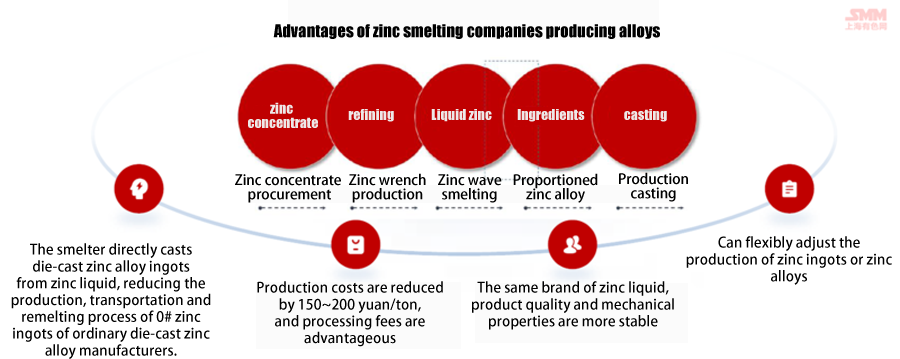
Origin and Development
In the late 19th century and early 20th century, zinc alloys were widely used in industry; during World War II, Germany lacked copper resources and used zinc alloys instead of copper alloys to make wear-resistant parts; in the late 1950s, copper resources were tight in the international market, zinc alloys were valued, and several typical die-cast zinc alloys were invented.
Background of the development of zinc alloys in China
At present, China's zinc smelters are facing the dilemma of small growth space for downstream consumption, fierce competition in the raw material market, rapid decline in concentrate processing fees, and losses in smelting. Expanding the zinc alloy market has become almost the only option for zinc smelters to extend the industrial chain and increase added value. By producing zinc alloys, it is possible to strengthen long-term and stable relations with large steel companies, thereby consolidating its own finished product sales channels and enhancing the company's ability to resist market fluctuations. At the same time, based on the expectation that the demand for zinc alloys will continue to grow in the future, the production of zinc-plated alloys in zinc smelters is becoming more and more universal. Direct production of zinc alloys can timely understand the changes in demand in the mainstream galvanized market, guide the product research and development direction of smelters, and achieve continuous technological innovation. Therefore, the main zinc smelters currently have the ability to produce zinc alloys, and the proportion of total output and zinc alloy output is increasing.
At present, there are almost no high-value-added deep-processing products in the zinc industry chain. The zinc-based alloys, zinc powders used in the galvanizing and die-casting fields, and zinc salts needed in the chemical industry have low added value. With the reduction of domestic zinc consumption space, the ceiling of the production scale of ordinary zinc ingots is about to appear, and major smelters generally turn their attention to zinc alloy production, including hot-dip galvanized alloys and die-casting alloys.
my country's die-casting industry has gone through four stages of development, from the embryonic stage in the 1950s to the rapid growth period of this century. Thanks to the rapid development of the national economy, the production and sales of automotive die-casting parts have increased significantly against the background of the rapid growth of my country's automobile industry, and have reached a certain scale.
At present, there is a clear trend for zinc smelting enterprises to produce zinc alloys by self-production or outsourcing zinc. Various zinc smelting enterprises have gradually shifted from only producing zinc ingots to producing alloys, and the number of enterprises producing zinc alloys has increased. With the increasingly stringent requirements of national environmental protection policies on zinc alloy production and cost competition, zinc alloy production will gradually develop towards the integration of cathode zinc-zinc alloys, and some production processes and equipment with small output, high energy consumption, large burnout and large pollution will be eliminated.

0# zinc ingot: production is mainly carried out by domestic smelters. Domestic smelting capacity is about 6.2 million tons. Consumer groups are mainly electroplating, alloy, plated pipe, plated parts, spraying, batteries, etc.
Hot-dip galvanized alloy: production is mainly carried out by domestic smelters. At present, the domestic production capacity is about 1.8 million tons, and the smelter involves a capacity of 1.1 million tons.
Alloys for batch galvanizing: the industry concentration is low, mainly private enterprises, and smelters are less involved. The current domestic production capacity is about 170,000 tons/year. The products are differentiated.
Die-cast zinc alloy: the domestic production capacity of die-cast zinc alloy is about 1.8 million tons, of which smelters account for about 30%. Involving locks, bathroom, door and window hardware, luggage hardware, clothing accessories, toys, electronic components, handicrafts and other industries.